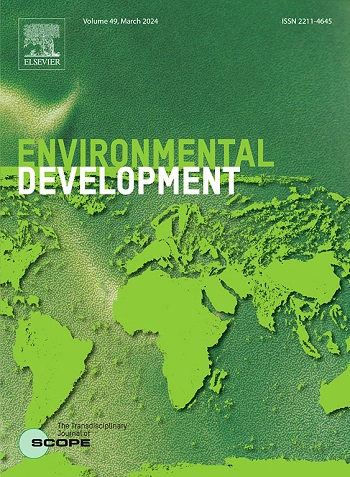Drivers of illegal mining in the Amansie West District using the partial lease square model
IF 5.3
2区 环境科学与生态学
Q2 ENVIRONMENTAL SCIENCES
引用次数: 0
Abstract
Illegal mining is one of Ghana's most prominent socioeconomic and environmental challenges. Despite several interventions by successive governments to deal with the menace, the activity continues to thrive largely because proposed interventions fail to address the underlying drivers of the challenge. Using quantitative data from face-to-face structured interviews conducted in the Amansie West, an illegal mining hotspot district in Ghana, this study analyzes the interrelations between the drivers of illegal mining using the Partial Lease Square (PLS) model. The model revealed a direct positive relationship between poverty, unemployment, and weak institutional, regulatory, and legislative frameworks and illegal mining while high mining profitability and corruption showed an indirect negative relationship with illegal mining. Furthermore, poverty and unemployment were observed to be the strongest and most significant positive drivers of illegal mining (estimate: 0.84, p-value: 0.001) followed by weak institutional, regulatory and legislative framework (estimate: 0.25, p-value: 0.0004). On the contrary, high profitability of mining (estimate: −0.18, p-value: 0.002) and corruption (estimate: −0.24, p-value: 0.002) recorded a significant but negative relationship with illegal mining. The study therefore concludes that initiatives undertaken by government agencies to ensure sustainability in the ASM sector mining must be rooted in livelihood diversification and poverty alleviation and in a balanced institutional, regulatory, and legislative environment.
司机非法采矿在阿曼西西区使用部分租赁方形模型
非法采矿是加纳最突出的社会经济和环境挑战之一。尽管历届政府采取了几次干预措施来应对这一威胁,但这一活动仍在继续蓬勃发展,主要是因为拟议的干预措施未能解决这一挑战的潜在驱动因素。本研究利用在加纳非法采矿热点地区Amansie West进行的面对面结构化访谈的定量数据,使用部分租赁平方(PLS)模型分析了非法采矿驱动因素之间的相互关系。该模型揭示了贫困、失业和薄弱的制度、监管和立法框架与非法采矿之间的直接正相关关系,而高采矿盈利能力和腐败与非法采矿之间的间接负相关关系。此外,贫困和失业被观察到是非法采矿最强大和最显著的积极驱动因素(估计:0.84,p值:0.001),其次是薄弱的制度、监管和立法框架(估计:0.25,p值:0.0004)。相反,采矿的高盈利能力(估计:- 0.18,p值:0.002)和腐败(估计:- 0.24,p值:0.002)与非法采矿呈显著但负相关。因此,该研究得出结论,政府机构为确保ASM部门采矿业的可持续性而采取的举措必须植根于生计多样化和减轻贫困,以及平衡的体制、监管和立法环境。
本文章由计算机程序翻译,如有差异,请以英文原文为准。
求助全文
约1分钟内获得全文
求助全文
来源期刊

Environmental Development
Social Sciences-Geography, Planning and Development
CiteScore
8.40
自引率
1.90%
发文量
62
审稿时长
74 days
期刊介绍:
Environmental Development provides a future oriented, pro-active, authoritative source of information and learning for researchers, postgraduate students, policymakers, and managers, and bridges the gap between fundamental research and the application in management and policy practices. It stimulates the exchange and coupling of traditional scientific knowledge on the environment, with the experiential knowledge among decision makers and other stakeholders and also connects natural sciences and social and behavioral sciences. Environmental Development includes and promotes scientific work from the non-western world, and also strengthens the collaboration between the developed and developing world. Further it links environmental research to broader issues of economic and social-cultural developments, and is intended to shorten the delays between research and publication, while ensuring thorough peer review. Environmental Development also creates a forum for transnational communication, discussion and global action.
Environmental Development is open to a broad range of disciplines and authors. The journal welcomes, in particular, contributions from a younger generation of researchers, and papers expanding the frontiers of environmental sciences, pointing at new directions and innovative answers.
All submissions to Environmental Development are reviewed using the general criteria of quality, originality, precision, importance of topic and insights, clarity of exposition, which are in keeping with the journal''s aims and scope.
 求助内容:
求助内容: 应助结果提醒方式:
应助结果提醒方式:


